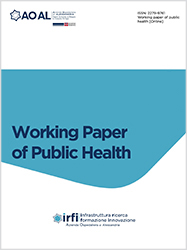Pleural mesothelioma: research of mechanisms involved in carcinogenesis. The role of CD10

All claims expressed in this article are solely those of the authors and do not necessarily represent those of their affiliated organizations, or those of the publisher, the editors and the reviewers. Any product that may be evaluated in this article or claim that may be made by its manufacturer is not guaranteed or endorsed by the publisher.
The present study was conducted at Surgical Pathology Department of “Santo Spirito” hospital in Casale Monferrato (AL) and in collaboration with the Cellular Biology and Physiology laboratory located in the institution of DiSIT-Università del Piemonte Orientale. In the pathology facility a retrospective analysis on the immunohistochemical expression of CD10 marker in malignant pleural mesothelioma was delineated. For this purpose it was collected a sample of 63 pleural biopsies with a diagnosis of pleural mesothelioma come in the period of January 2015 and November 2020. In this cohort, CD10 expression was assessed from a prognostic perspective and in relation to morphologic aspects of the neoplasm. Results from previous analysis built the basis of the experiment conducted in the DiSIT facility. Two pleural mesothelioma cell lines, REN and MM98, got incubated with the cytokine TGF-β aiming to analyze the potential relationship between epithelial-to-mesenchymal transition (EMT) and CD10 cell expression pattern. Bioinformatic server Haddock 2.4 helped to predict and model potential cross-talk between EMT underlying pathways and CD10 signalling.
Objectives: The present study aimed to assess prognostic role of CD10 immunohistochemical expression in a cohort of patients affected by pleural mesothelioma. Second goal was to analyze the relationship between CD10 biopsy expression, phenotypical and imunophenotypical features (referring in particular to PDL-1 expression) of the neoplasm. Results from this retrospective analysis established next aim of the study: induction of EMT in two mesothelioma cell lines, REN and MM98, and analysis of change in CD10 cellular pattern. Final goal was to predict a potential cross-talk between EMT related pathways and CD10 activity based on bioinformatic server Haddock 2.4.
Methods: Immunohistochemical analysis of biopsies and cell cultures were processed on Ventana Benchmark immunostainer. Tools adopted in qRT-PCR of cell cultures were: Power Sybr Green Mastermix probes (Ambion Austin, TX, USA) and KiCqStart® SYBR® Green primers (Sigma-Aldrich); Real-Time PCR CFX384 detection system (Bio-Rad Laboratories, Hercules, CA, USA). Gene expressione was measured with ∆∆Ct method. Parametrization of CD10 immunohistochemical expression was accomplished with cell imaging software CellProfiler 3.1.9. Statistical analysis were ran with R software version 3.6.2. Results: CD10 showed to be a negative prognostic factor, positively associated to neoplastic grade, in the cohort of patients analyzed. Induction of EMT in REN and MM98 TGF-β treated cultures, augmented CD10 cytosolic expression against non-treated cultures. Specifically, a change in CD10 immunoexpression pattern, from membranous to cytosolic, was observed for EMT+ REN cell culture. This data agrees with prevalent CD10 cytosolic expression observed in mesothelioma with low differentiation, where differentiation represents a function of EMT. Furthermore, Haddock data highlighted a potential promotion of EMT by CD10 via a NF-kB interaction. CD10 could establish a positive feedback loop with EMT.
Conclusion: CD10 represents a positive marker of neoplastic progression in pleural mesothelioma that, based on its expression level, can stratify survival. Experimental data showed that CD10 could be upregulated by EMT pathways. Bionformatic analysis also suggest that CD10 could interact with EMT establishing a positive feedback loop. Clarifying tumorigenicity of CD10 in mesothelioma is fundamental to define its possible therapeutic role.
PAGEPress has chosen to apply the Creative Commons Attribution NonCommercial 4.0 International License (CC BY-NC 4.0) to all manuscripts to be published.

 https://doi.org/10.4081/wpph.2021.9453
https://doi.org/10.4081/wpph.2021.9453




